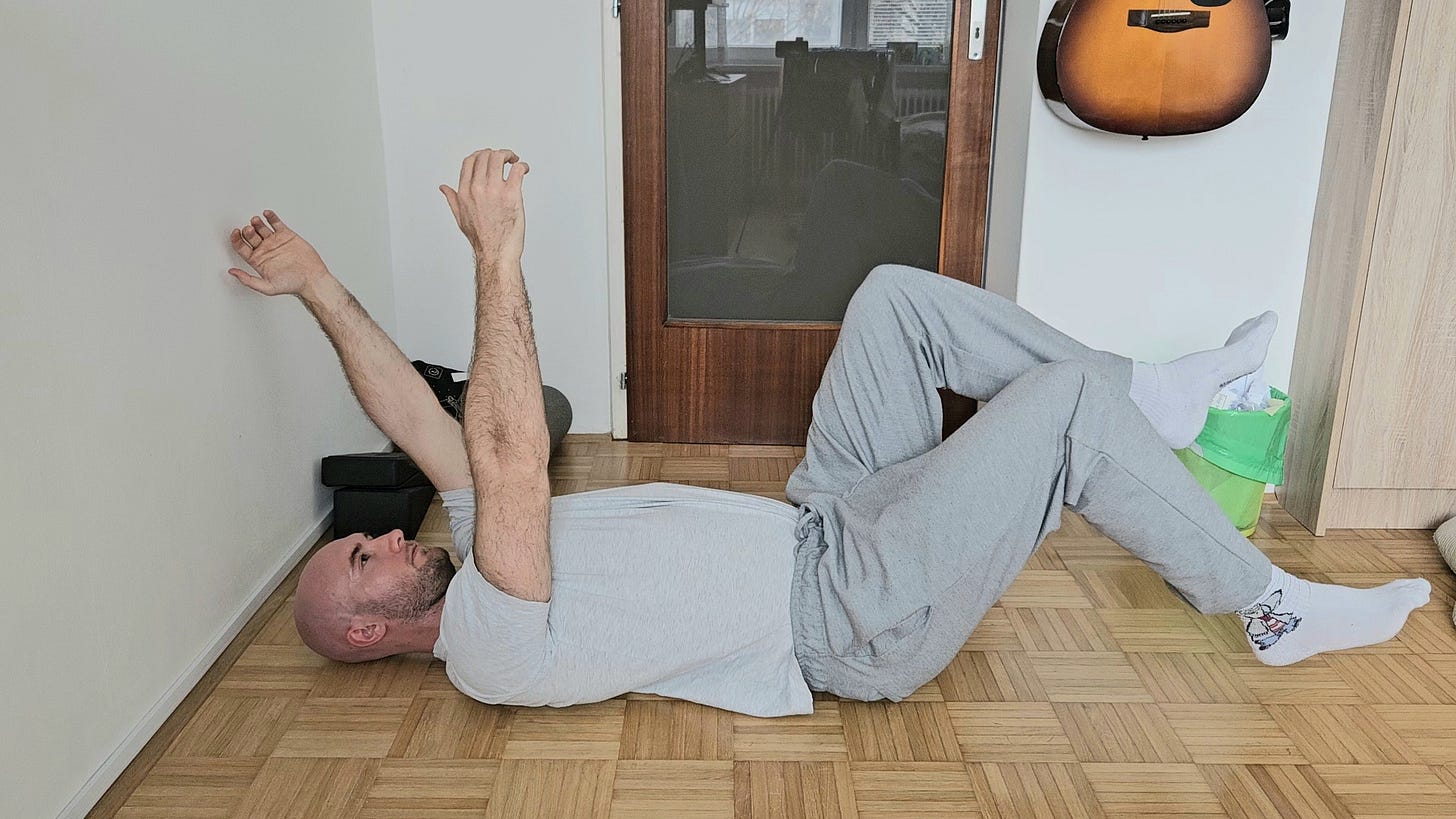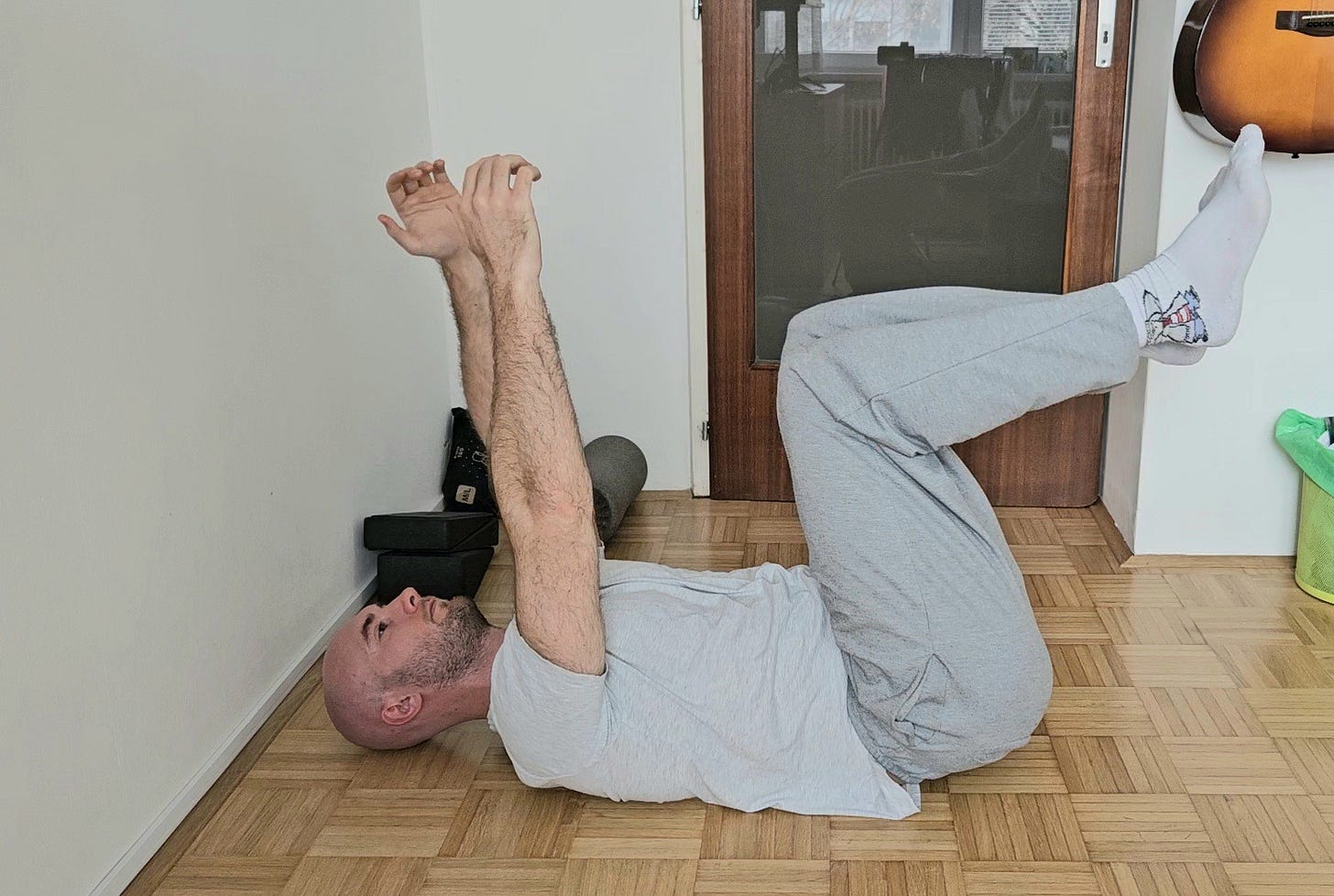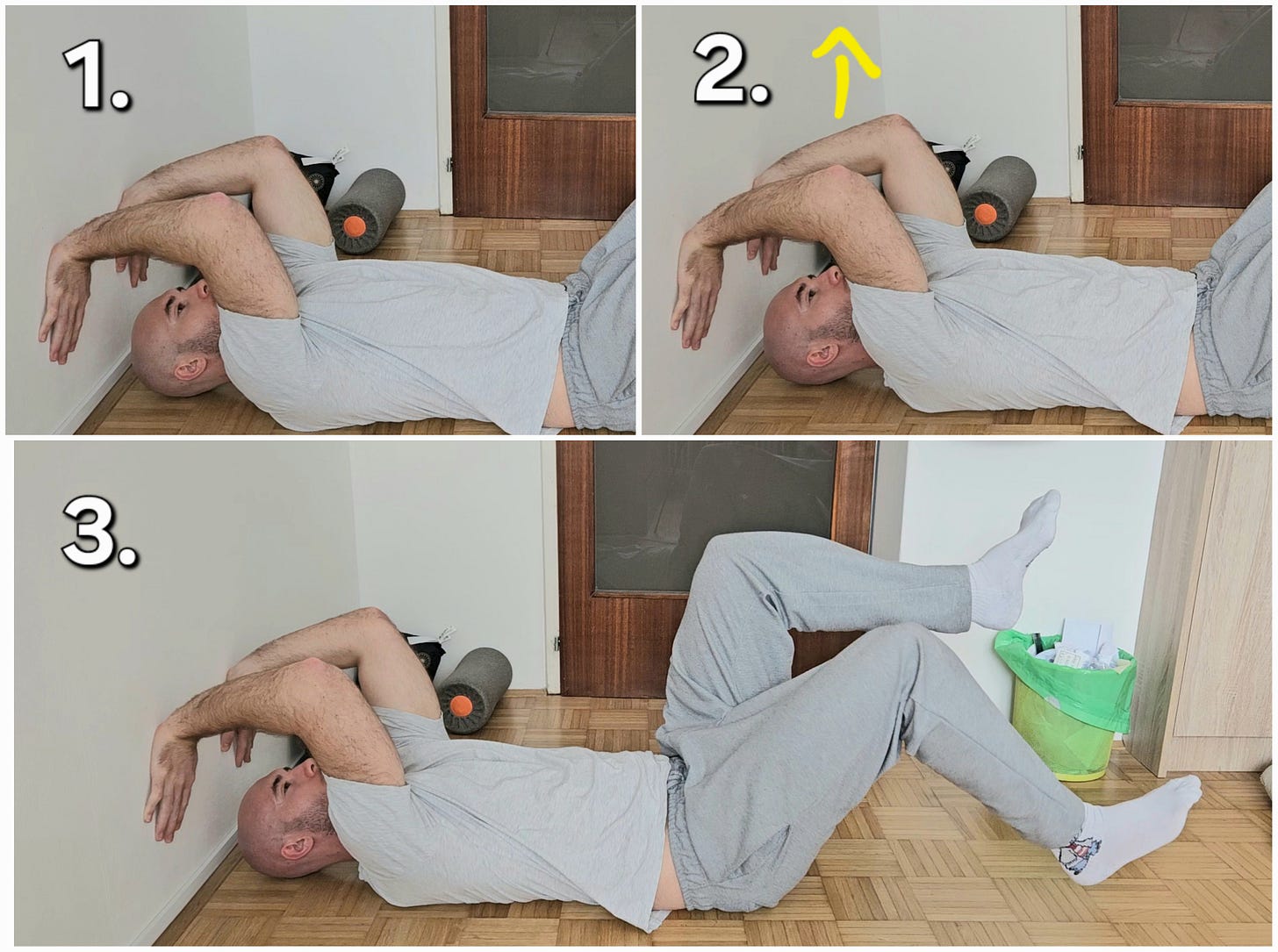Free post - Lower back pain during dead bug exercise?
Try not to press lower back into the floor.
In the coaching and therapeutic fields, there is often a common belief that weak abdominal muscles lead to lower back issues.
Reduced control—and consequently the diminished ability for concentric action—of specific abdominal muscles (depending on the individual) can cause the spine to move excessively or adopt new positions, triggering pressure in the lower back.
The dead bug is one of the exercises used to increase abdominal muscle activity and often helps release tension in the lumbar region.
However, for the exercise to be truly effective, it must be performed mindfully and with attention to common mistakes.
1. Lifting the lower back off the ground
The dead bug exercise involves moving the arms and/or legs. As the arms move overhead and the legs extend outward, the lever (the distance between the body’s center and the limbs) increases. This means the abdominal muscles must work harder.
If the muscles can no longer sustain the load, the lower back starts to lift off the floor—at which point the back, rather than the abdominals, takes over control.
Letting the lower back leave the floor isn’t the best strategy, especially if the goal is to relieve tension in the lumbar area.
On the other hand, an instruction such as…
2. “Push your lower back on the floor” isn’t exactly the best cue
The common cue “press your lower back into the floor” often leads to excessive pressure in the lumbar area—just in the opposite direction. Instead of increasing the lumbar curve (as before), it now flattens or even reverses it.
This strongly activates the rectus abdominis (the front abdominal muscle), which runs from the sternum to the pelvis. However, since the sternum has the ability to bend, its activation causes the upper chest to collapse forward. This compresses the area around the 5th to 7th ribs, creating pressure not only in the lower back, but also in the front of the chest.
If we translated this floor position into upright posture, it would resemble the so-called “sway back” posture, where the hips are pushed forward and the upper front body is tilted downward.
It’s true that this approach increases abdominal muscle activation, but primarily through one superficial muscle—the kind we’d rather save for beach season than rely on during this exercise.
The “six-pack” muscle strategy tends to appear when the head is lifted or when the knees are no longer positioned directly above the hips. In those moments, the pelvis tends to tilt backward—especially when the hips lack the mobility required for flexion.
So how should the exercise be performed?
If the exercise is appropriate at the current stage of the process, it will be most effective when the lumbar spine maintains as consistent pressure as possible throughout the movement.
For better control of that pressure, the exercise can be performed with the hands pressing against a wall.
Placing the palms on the wall provides an additional reference point, making it easier to control the center of the body.
Instructions
Place your palms on the wall so that your elbows are shoulder-width apart and bent at roughly 90 degrees.
As you exhale, gently push your elbows slightly upward toward the ceiling, and maintain their height and width throughout the entire exercise.
Inhale, and on the exhale, slowly lower one (or both, depending on difficulty) leg(s) toward the floor—only as far as you can go without letting your lower back lift off the ground or increase its pressure into the floor.
That’s it for today's episode of Movement Vault. If you have any questions or ideas for topics you’d like to learn more about, please send me a message or leave a comment below. Thanks for your support!
If you found this post helpful, I kindly ask for a like.
I would greatly appreciate every share among your colleagues (if 5 people subscribe through your referral, you will receive 1 month of free subscription).
Enjoy your week.
Until next time, Domen
V trenerski in terapevtski stroki je pogosto prisotno razmišljanje, da šibke trebušne mišice pripeljejo do težav v ledvenem delu.
Slabša kontrola in posledično tudi sposobnost koncentrične akcije določenih trebušnih mišic (odvisno od posameznika) ima možnost v hrbtenici ustvariti dodatno gibanje ali nove položaje, ki zbudijo pritisk v križu.
Mrtvi ščurek je ena izmed vaj s katero povečamo aktivnost trebušnih mišic in pogosto sprosti zakrčenost ledvenega dela.
A da bi bila vaja res učinkovita, je pomembno, da jo izvajamo premišljeno in se izognemo pogostim napakam.
1. Dvig ledvenega dela od tal
Vaja mrtvi ščurek vključuje premikanje rok in/ali nog. Ko roke premikamo nad glavo, noge pa proti iztegu, se ročica (razdalja med središčem telesa in okončinami) podaljšuje. To pomeni, da trebušne mišice potrebujejo opravljati več dela.
Če mišice te obremenitve ne zmorejo več zadržati, se začne ledveni del dvigovati od tal – in takrat nadzor prevzame hrbet, namesto trebuha.
Strategija zapuščanja križa od podlage ni ravno najboljša, če je naš namen stanje s križem olajšati.
Po drugi strani pa navodilo, kot je …
2. “Pritisni križ na tla.” ni ravno najboljša izbira
Pogosto navodilo »potisni križ v tla« vodi v pretiran pritisk v ledvenem delu – le v drugo smer. Namesto da bi ledveno krivino povečali (kot prej), jo zdaj izravnamo ali celo obrnemo v nasprotno smer.
To močno aktivira mišico rectus abdominis (sprednjo trebušno mišico), ki poteka od prsnice do medenice. A ker ima prsnica možnost zvijanja, njena aktivacija povzroči, da se zgornji del prsnega koša zvije naprej. To stisne predel okrog 5.–7. rebra in povzroči pritisk ne le v križu, temveč tudi v sprednjem prsnem delu.
Če bi položaj na tleh predstavili v telesni drži, bi drža izgledala kot tako imenovana “sway back” drža, kjer so boki potisnjeni naprej, zgornji sprednji del pa obrnjen proti tlom.
Je res, da tako pridobimo več aktivacije trebušnih mišic, ampak na račun ene površinske mišice, ki si jo bolj kot za to vajo želimo imeti takrat, ko je čas za na plažo.
Strategija mišice “six pack” bo prisotna takrat, kadar dvignemo glavo ali pa ko kolena ne bodo več direktno nad kolki. Takrat ima medenica možnost obrata nazaj predvsem takrat, kadar kolki nimajo sposobnosti (mobilnosti) upogiba.
Kako torej izvesti?
V kolikor je vaja v trenutnem času procesa ustrezna, bo največji doprinos imela takrat, ko ledveni del tekom vaje poskuša ohranjati čim bolj konstantni pritisk.
Za večjo kontrolo nad pritiskom imamo možnost vajo izvesti s pomočjo rok na steni.
Položaj z dlanmi na steni nam omogoča dodatno referenčno točko in posledično lažje kontroliranje centra telesa.
Navodila
Dlani postavi tako, da so komolci v širini ramen in tvorijo približno 90°.
Komolce z izdihom rahlo potisni proti stropu in jih tekom vaje z višino in širino tam ves čas ohranjaj.
Vdihni in z izdihom počasi preidi z eno (ali obema, odvisno od težavnosti) nogo počasi proti tlom le toliko, da ledveni del ne zapušča podlage ali pa da z njim pritiska v tla ne povečuješ.
Če ti je objava vsaj malo koristila, te skromno prosim za en všeček.
Za vsako deljenje objave med svojimi kolegi ti bom izredno hvaležen (če se nam nam zaradi tvoje povezave pridruži 5 ljudi, pridobiš 1 mesec brezplačne naročnine).
Toliko v današnji epizodi Gibalne zakladnice+. Če imaš kakšno vprašanje ali idejo za temo, o kateri želiš izvedeti več, mi napiši sporočilo ali pusti komentar spodaj. Hvala za tvojo podporo!
Uživaj v tednu.
Do naslednjič,
Domen.









